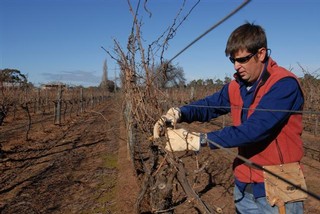How to prune your grapevine? 3 easy steps
How to prune a vine in 3 easy steps.
This is probably one of the most asked questions during autumn and winter.
Winter is when the vines are dormant, that’s when the vines rest and rejuvenate before their growing cycle starts again in Spring with budburst.
This dormant time, winter is the best time to prune, while the vines are bare. In the Swan Valley the earliest we can start is once about 90% of the vineyard leaves have dropped.
Pruning is all about creating a balanced vine and so, a balanced vineyard. This is critical to making great wine, as ultimately wine is fermented grape juice, so we want each vine to be perfectly balanced.
However all you want to know is how to prune the vine at your house!
And it is easy.
If your vine is fairly established (about 4 feet high) it will be almost impossible to kill it!
Pruning will be about creating the shape or guiding it to where you want it to grow.
- Choose a couple of strong branches (a bit thicker than a pencil’s thickness)
- Wind the branches/canes where you want them to grow –probably to create shade in summer.
- Cut everything else away
Seriously get rid of everything else. Each bud or nobbly bit on that vine branch is going to turn into a branch of its own!
The roots are all still there, so the bigger the root system the more growth they force out through whatever new wood you’ve laid down.
But in the vineyard, it’s a bit more complicated…
Derek and Lauren will look at each vine, choosing the strongest shoots (or branches) to keep, cutting off weak ones and creating an even, symmetrical shape.
A well pruned vine will produce the best sized fruit, which will ripen evenly, as there will be the right number of bunches of grapes for that specific vine.
There are two ways to prune grapevines:
- Cane pruning
- Spur pruning
How to Cane Prune
- Choose 2-4 strong 1 year old canes (slightly thicker than a pencil’s width) to leave on the trunk.
- Cut off all other canes, cut them as close to the vine’s trunk as possible.
- Wrap the remaining 2-4 canes along the trellis wire. The new shoots will sprout in spring, one from each bud.
The advantages are increased yield, the canopy is more open so the air can better circulate around the fruit and better (more) fruit set.
The major disadvantage is that it’s a lot harder, so takes a lot longer, needs more skilled people and is a lot more expensive to do.
How to Spur Prune:
You need to have trained the vine into a T shape, with a strong truck, and two cordons, each running on ether side of the main trunk.
- Cut away the existing canes to a spur or small stem where a cluster of shoots can grow from. Each spur or stem ought to have 2 buds on it.
- Cut away any remaining canes
- Remove any unwanted canes, that aren’t in the right place.
Spur Pruning is a lot quicker and easier than Cane Pruning, and we can get a mechanical ‘pre-pruner’ in, that cuts a lot of the excess wood into pencil lengths, so they fall away from the canopy and don’t need to be pulled out by hand!
However it does seem to reduce the vine’s yield over time and can lead to smaller berries (depending on the variety this can be a positive too).
At Upper Reach we do a mix of spur and cane pruning, to ensure that we grow the very best grapes for your wines.